Introduction: An Artist of Transatlantic Experience
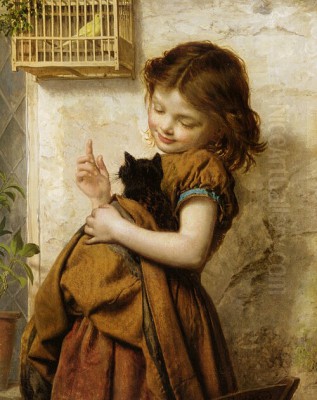
Sophie Gengembre Anderson (1823-1903) stands as a significant, albeit sometimes overlooked, figure in the landscape of nineteenth-century British art. Born in Paris to a French father and an English mother, her life and career traversed continents and artistic movements, ultimately leaving a legacy rich in tender depictions of children, idyllic rural scenes, and nuanced portrayals of women. Though associated with the spirit of the Pre-Raphaelite movement, Anderson developed a distinct style characterized by meticulous detail, vibrant colour, and a deep sensitivity to the emotional lives of her subjects. Her journey from France to America and finally to England shaped her perspective, allowing her to capture moments of innocence, contemplation, and everyday life with remarkable charm and technical skill.
Early Life and Artistic Awakening
Sophie Gengembre was born into an environment that nurtured creativity. Her father, Charles Antoine Colomb Gengembre, was a successful Parisian architect and engineer, ensuring the family was well-connected and comfortable. Her English mother provided a link to Britain that would become increasingly important later in life. Despite this artistic background, Sophie's formal art education was limited. She displayed a passion for drawing and painting from a young age but was largely self-taught. A brief period of study focused on portraiture under Charles de Steuben in Paris around 1843 provided some formal instruction, but her development as an artist primarily stemmed from her own dedicated observation and practice. This self-reliance perhaps contributed to the unique and personal quality found in her later work.
The political climate of France intervened in the family's life. The revolutions that swept through Europe, particularly the 1848 Revolution in France, prompted the Gengembre family to seek stability elsewhere. They emigrated to the United States, initially settling in Cincinnati, Ohio, a city with a growing artistic community. This move marked a pivotal point in Sophie's life, transplanting her from the established art world of Paris to the burgeoning cultural landscape of mid-nineteenth-century America.
American Years: Forging an Identity and Partnership
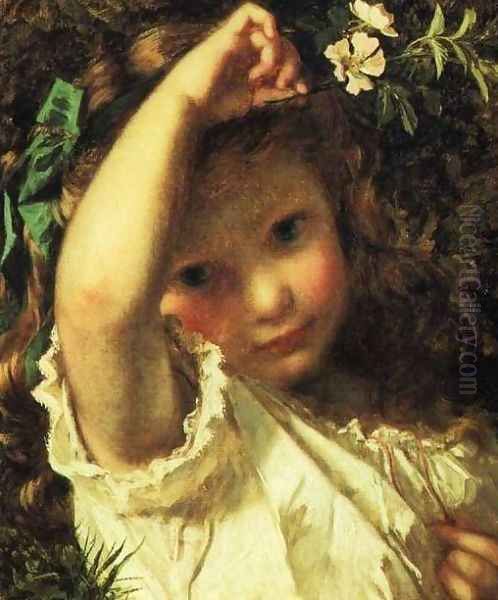
In America, Sophie Anderson quickly began to establish herself professionally. She initially found work leveraging her artistic skills in practical ways, including creating lithographs for companies like Louis Prang and Co., who would become famous for popularizing the Christmas card. Her talent for capturing likenesses also led her to portraiture. The family later moved from Ohio to Manchester, Pennsylvania, near Pittsburgh. It was during this period in Pennsylvania that she encountered Walter Anderson, a fellow British artist specializing in genre painting.
Their shared passion for art and British roots formed a strong bond, leading to their marriage. The partnership extended into their professional lives; they collaborated on various projects, most notably a series of portraits of American Protestant Episcopal bishops. This collaboration suggests a supportive artistic relationship where skills and ideas were likely shared. Walter Anderson's focus on genre painting may have also influenced Sophie's increasing interest in depicting scenes of everyday life, moving beyond formal portraiture. Her time in America was crucial for honing her skills and beginning to define the thematic concerns that would dominate her mature work.
Development of Artistic Style: Romanticism and Pre-Raphaelite Echoes
Sophie Anderson's artistic style evolved throughout her career, absorbing influences while retaining a distinct personal vision. Early works show traces of Romanticism, evident in the emotional sensitivity and idealization of her subjects. However, as she matured, her style became increasingly aligned with the aesthetic principles of the Pre-Raphaelite Brotherhood, though she was never formally a member. This connection is seen in her meticulous attention to detail, the brilliance and clarity of her colour palette, and her frequent choice of subjects imbued with symbolic or narrative meaning.
Like prominent Pre-Raphaelites such as John Everett Millais and William Holman Hunt, Anderson rendered textures – fabrics, foliage, flowers, skin – with painstaking care. Her paintings often feature a high degree of finish and a luminous quality, achieved through careful layering of pigments. Unlike the sometimes stark medievalism or intense religious drama found in the work of figures like Dante Gabriel Rossetti, Anderson's subjects were typically gentler, focusing on the perceived innocence of childhood and the quiet dignity of rural life. She blended a classical sense of grace and composition with a Victorian appreciation for sentiment and narrative detail, creating works that were both aesthetically pleasing and emotionally resonant.
Key Themes: Childhood, Nature, and Domesticity
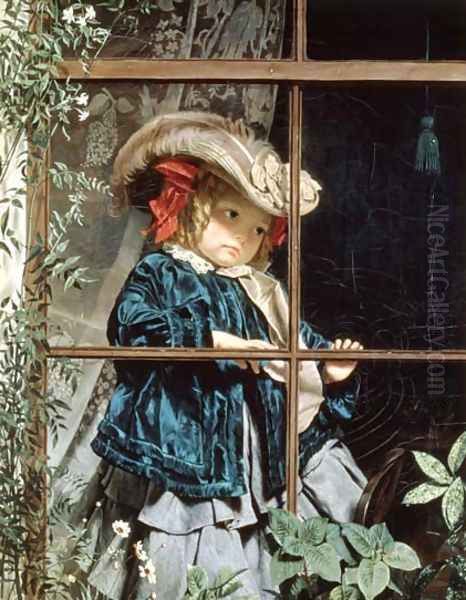
The heart of Sophie Anderson's oeuvre lies in her sensitive and idealized portrayal of children. She captured them not merely as miniature adults, but as beings inhabiting their own world, full of curiosity, contemplation, and unguarded emotion. Often depicted in lush, natural settings – surrounded by wildflowers, interacting with animals, or caught in moments of quiet play – her child subjects embody a Victorian ideal of innocence and purity, closely connected to the perceived wholesomeness of nature. Works like Peek-a-Boo or The Children's Story Book exemplify this focus, showcasing her ability to convey tenderness and narrative through subtle gestures and expressions.
Rural life and domesticity were also central themes. Anderson frequently painted young women, often in rustic interiors or garden settings, engaged in simple activities like reading, sewing, or tending flowers. These scenes evoke a sense of tranquility and idealized femininity popular in the Victorian era. Her detailed rendering of clothing, interiors, and natural elements grounds these scenes in a tangible reality, while the overall mood often remains one of peaceful sentiment. She shared this interest in rural and domestic subjects with contemporaries like Helen Allingham and Myles Birket Foster, though Anderson's approach often carried a more pronounced Pre-Raphaelite intensity in its detail and colour.
Masterworks and Signature Pieces
Several paintings stand out as defining examples of Sophie Anderson's talent and thematic concerns. No Walk Today (circa 1856) is perhaps her most famous work, particularly renowned for its high market value. It depicts a young girl, exquisitely dressed, gazing wistfully out of a window, presumably disappointed by bad weather preventing an outing. The painting is a masterclass in capturing subtle emotion and rendering intricate detail, from the lace on the girl's dress to the raindrops visible on the windowpane. Its immense popularity speaks to its embodiment of Victorian sentimentality and Anderson's skill in portraying childhood feelings. The work's record-breaking sale price in 2008 cemented its status as a key piece in her legacy.
Elaine, also known as Elaine of Astolat (1870), demonstrates Anderson's engagement with literary themes, a common practice among Pre-Raphaelite artists. Inspired by Alfred, Lord Tennyson's poem Lancelot and Elaine from his Idylls of the King, the painting depicts the tragic Lily Maid of Astolat drifting down the river to Camelot after dying of unrequited love for Sir Lancelot. Anderson captures the pathos and beauty of the scene with delicate precision. This work holds historical significance as it was the first painting by a female artist purchased by the Walker Art Gallery in Liverpool for its public collection (1871), marking a milestone for women artists in Britain.
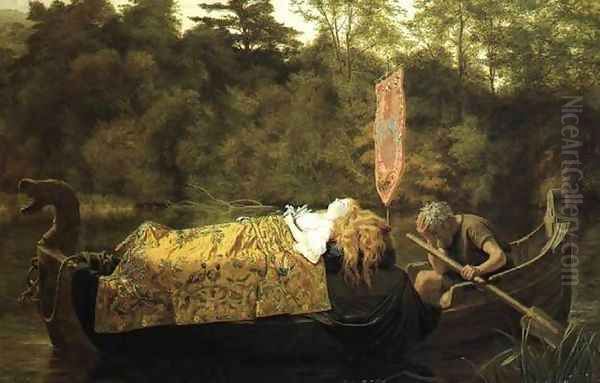
Neapolitan Child reflects the period Anderson spent in Italy. It showcases her ability to adapt her style to different cultural settings, capturing the distinct features and vibrant character of her Italian subjects while maintaining her signature detail and warmth. Another notable work, The Song of the Lark, shares its title with a famous painting by the French realist Jules Breton, though Anderson's interpretation likely focuses on the theme of nature and innocence, possibly depicting a rural child listening to the bird's song at dawn, symbolizing hope or natural beauty. Her exploration of Orientalist themes is evident in Scheherazade, indicating a breadth of interest beyond her typical subjects, perhaps influenced by popular trends seen in the work of artists like Jean-Léon Gérôme or John Frederick Lewis.
The Italian Interlude: Health and Artistic Exploration
In the early 1870s, concerns over Sophie Anderson's health prompted a significant change of scenery. Seeking a warmer, more beneficial climate, she and her husband Walter moved to the island of Capri in Southern Italy. This Mediterranean setting offered new visual stimuli and cultural experiences, which inevitably found their way into her art. The vibrant light, distinct landscapes, and local people of Capri provided fresh subject matter.
During her time in Italy, she continued to paint prolifically, producing works that often blended the picturesque qualities of Italian peasant life with the detailed finish characteristic of her established style. Paintings like Neapolitan Child and others depicting local children and scenes directly resulted from this period. While living abroad, she maintained connections with the British art world, regularly sending works back to London for exhibition at prestigious venues like the Royal Academy and the Society of British Artists. This period demonstrates her resilience as an artist, continuing to create and exhibit despite health challenges and geographical distance from the main centre of the British art market. It also broadened her artistic vocabulary, adding an Italianate flavour to her repertoire.
Return to England and Later Career
After spending several years in Capri, Sophie and Walter Anderson returned to England in 1894. They chose to settle in Falmouth, Cornwall, a picturesque coastal town popular with artists. Cornwall, particularly the areas around Newlyn and St Ives, was becoming a significant art colony, attracting painters drawn to its dramatic coastal scenery and unique quality of light. Artists like Stanhope Forbes and Walter Langley were establishing the Newlyn School, focusing on realistic depictions of local fishing communities. While Anderson's style differed from the plein air social realism of the Newlyn painters, her presence in Falmouth placed her within this vibrant artistic milieu during her final years.
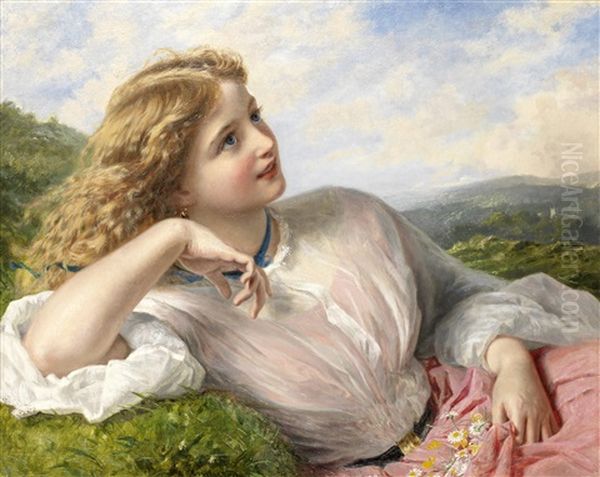
In Falmouth, she continued to paint, though perhaps less prolifically than before. Her focus remained largely on the subjects that had defined her career: children, genre scenes, and studies of nature, rendered with her characteristic precision and charm. She lived out her remaining years in Cornwall, passing away in Falmouth in 1903 at the age of 80. She was buried alongside her husband Walter (who predeceased her) in the local Swanvale cemetery. Her later years represent a quiet culmination of a long and productive career spent observing and translating the world around her into art.
Connections and Context: A Wider View
Sophie Anderson's career intersected with various artistic currents and figures. Her primary artistic partnership was with her husband, Walter Anderson. Their collaboration on portraits in America highlights a professional synergy. While Walter's individual artistic reputation is less prominent than Sophie's today, their shared life undoubtedly involved mutual artistic influence and support.
Her connection to the Pre-Raphaelite movement is significant, though largely stylistic and thematic rather than through direct association. She embraced their emphasis on truth to nature, detailed execution, and vibrant colour, applying it predominantly to genre subjects rather than the medieval or intensely symbolic narratives favoured by the core Brotherhood members. Her work can be seen as a more accessible, perhaps more sentimental, interpretation of Pre-Raphaelite aesthetics, bringing its intensity to bear on scenes of childhood and domesticity. Comparisons can be drawn to the detailed naturalism of William Henry Hunt's still lifes or the intricate foliage in John Brett's landscapes.
Within the context of Victorian women artists, Anderson holds an important place. She achieved considerable professional success in a male-dominated field, exhibiting widely and securing public commissions like the Walker Art Gallery purchase of Elaine. Her work shares thematic ground with other female artists focusing on children and domestic life, such as the popular illustrator Kate Greenaway or the watercolourist Helen Allingham, yet Anderson's oil painting technique and Pre-Raphaelite affinities set her apart. She navigated the art world alongside other notable female figures like the spiritually inclined painter Evelyn De Morgan and the artist and model Elizabeth Siddal, who was closely associated with the Pre-Raphaelite circle.
Her painting Elaine also invites comparison with other Victorian interpretations of Arthurian legend, such as John Atkinson Grimshaw's atmospheric depictions of The Lady of Shalott. Her brief foray into Orientalism with Scheherazade connects her to a broader European fascination with the East, explored by numerous artists during the period.
Market Recognition and Enduring Legacy
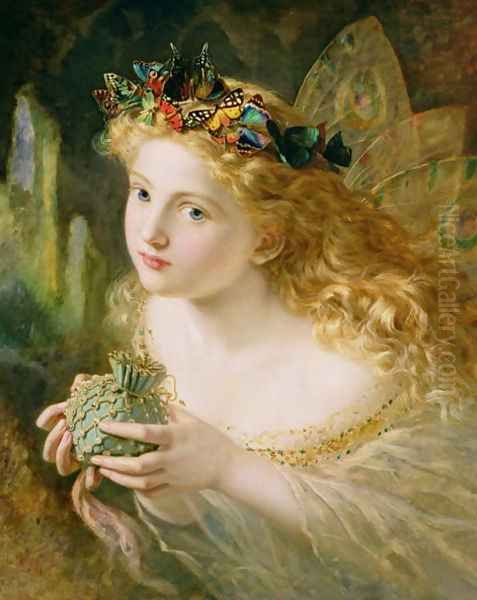
For much of the twentieth century, Sophie Anderson's work, like that of many Victorian genre painters, particularly women, received limited critical attention. However, a reappraisal of Victorian art and a growing interest in the contributions of female artists have brought her back into the spotlight. The landmark sale of No Walk Today at Sotheby's in 2008 for over £1 million dramatically underscored her market value and public appeal. This sale not only set a record for the artist but also highlighted the increasing collector interest in high-quality Victorian genre painting.
The acquisition of Elaine by the Walker Art Gallery in 1871 remains a significant point in her legacy, marking early public recognition of a female artist's work. Today, her paintings are held in various public collections, including the Walker Art Gallery, Liverpool, and the Wolverhampton Art Gallery, among others. Her work is admired for its technical proficiency, particularly her handling of light, texture, and colour, and for the enduring charm and sensitivity of her depictions of childhood.
Sophie Anderson's legacy lies in her ability to capture the nuances of Victorian sentiment through meticulously crafted images. She excelled in portraying the world of children with empathy and grace, creating idealized yet emotionally resonant scenes. As a successful female artist who navigated the transatlantic art world and achieved significant recognition during her lifetime and posthumously, she serves as an important figure in the study of nineteenth-century British art and the history of women artists. Her paintings continue to delight viewers with their beauty, detail, and gentle observation of life.
Conclusion: A Delicate Realism
Sophie Gengembre Anderson carved a unique path through the art world of the nineteenth century. From her beginnings in Paris and formative years in America to her established career in England and Italy, she developed and refined a style that combined meticulous realism with heartfelt sentiment. Her focus on the innocence of childhood and the quiet beauty of rural and domestic life resonated deeply with Victorian audiences and continues to find appreciation today. While influenced by Romanticism and closely aligned with the aesthetics of the Pre-Raphaelites, her vision remained distinctly her own. The technical brilliance of her work, coupled with the emotional warmth of her subjects, ensures her enduring appeal. As art history continues to uncover and celebrate the contributions of women artists, Sophie Anderson's place as a skilled and sensitive chronicler of her time is secure. Her paintings remain testaments to a life dedicated to observing and capturing moments of tenderness, beauty, and quiet contemplation.